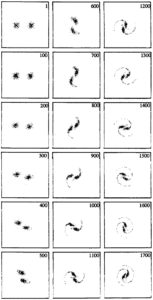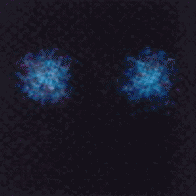Galaxy formation in the Plasma Universe is modeled as two adjacent interacting Birkeland filaments. The simulation produces a flat rotation curve, but no hypothetical dark matter is needed, as required by the conventional model of galaxy formation.
The simulations derive from the work of Winston H. Bostick who obtained similar results from interacting plasmoids.[1] [2]
In the early 1980s Anthony L. Peratt, a student of Alfvén’s, used supercomputer facilities at Maxwell Laboratories and later at Los Alamos National Laboratory to simulate Alfvén and Fälthammar’s concept of galaxies being formed by primordial clouds of plasma spinning in a magnetic filament.[3]
The simulation began with two spherical clouds of plasma trapped in parallel magnetic filaments, each carrying a current of around 1018 amperes. The clouds spin around each other until a spiral shape emerges. Peratt concluded that the shapes seen in the simulation appeared similar to observed galaxy shapes, and posited a morphological sequence that corresponded to Halton Arp’s ideas that galaxies formed out of quasars ejected from AGN.[4] Perrat’s spirals had qualitatively flat rotation curves.
Experiments with the PK-3 Plus (Plasmakristall-3 Plus) dusty/complex plasmas laboratory on the International Space Station, has shown dusty plasmas in a weightless environment that seem to show “vortices in the plasma resembling a galaxy”,[5] and a “mini-galaxy [that] can be used to study formation of real galaxies”.
Simulation characteristics

Peratt further notes that:[3] “When scaled to cosmic dimensions the simulations show:
- a burst of synchrotron radiation of luminosity ~1037 W lasting 107-108 years as the interaction began;
- isophotal topologies of double radio galaxies and quasars, including juxtapositioned “hot spots” in the radio lobes (cross sections of the interacting Birkeland currents);
- the formation of “dust lane” peculiar and elliptical galaxies at the geometric center of quasars and radio galaxies (due to plasma trapped and compressed within the elliptical magnetic separatrix);
- a spatially varying power law along the major axis of the simulated double radio galaxies in agreement with observations;
- alternating beams of betatron-pumped synchrotron-emitting electrons on either side of the elliptical center (these have the morphologies (i.e., “knots” or vortices) and polarization properties of jets); and
- a “superluminosity” and fading of jets as the betatron-induced acceleration field sweeps over and ignites previously confined plasma.”
Peratt continues: “The simulation time frame of this investigation lasted some 108-109 years. The lifetime and evolution of quasars
and double radio sources, the so-called end problem of double radio galaxies, was addressed in this paper (Paper II) by continuing the simulation run ~1-5 x 109 years farther in time. This extension of the simulation showed:
- the transition of double radio galaxies to radioquasars to radioquiet QSO’s to peculiar and Seyfert galaxies, finally ending in spiral galaxies;
- the formation of irregular and dust lane galaxies, as well as more flattened E and S0 galaxies within the magnetic separatrix;
- barred and normal spiral galaxies resulting from the inflow of plasma from the outer Birkeland currents onto the the elliptical galactic center; the characteristic rotational velocities of spiral galaxies including the fine-detail vortex cotangent structure on the “flat” portions of the spiral-arm velocity components;
- replications of the morphologies of multiple interacting galaxies;
- “horseshoe” like regions of nearly neutral Hi gas in spiral galaxies resulting from the convection and neutralization of plasma into regions of strong galactic magnetic fields; and
- toroidal and poloidal components of the galactic magnetic field with field strengths reaching 2 x 10-4 G at the galactic center (fields as high as 10-2 G can occur in concentrated regions). These results were reported prior to their observation in the Galaxy”
Notes
- ↑ Bostick, W. H., “Experimental Study of Plasmoids“,FULL TEXT Electromagnetic Phenomena in Cosmical Physics, Proceedings from IAU Symposium no. 6. Edited by Bo Lehnert. International Astronomical Union. Symposium no. 6, Cambridge University Press (1958) p.87
- ↑ Bostick, Winston H., “Possible Hydromagnetic Simulation of Cosmical Phenomena in the Laboratory“,FULL TEXT Cosmical Gas Dynamics, Proceedings from IAU Symposium no. 8. Edited by Johannes Martinus Burgers and Richard Nelson Thomas. International Astronomical Union. Symposium no. 8, (1958) p. 1090
- ↑ 3.0 3.1 A. Peratt, “Evolution of the Plasma Universe: II. The Formation of Systems of Galaxies, IEEE Trans. on Plasma Science (ISSN 0093-3813), PS-14, 763–778 (1986). Full text FULL TEXT PDF (1.7M)] PEER REVIEWED
- ↑ Anatomy of a Galaxy in Evolution
- ↑ “Plasma in space experiment“, YouTube, published 4 Dec 2012, retrieved 9 Nov 2013. See also “PK-3 Plus” at the Max Planck Institute for extraterrestrial Physics
References
- Bostick, W. H., “Experimental Study of Plasmoids“,FULL TEXT Electromagnetic Phenomena in Cosmical Physics, Proceedings from IAU Symposium no. 6. Edited by Bo Lehnert. International Astronomical Union. Symposium no. 6, Cambridge University Press, p.87 PEER REVIEWED
- Bostick, Winston H., “Possible Hydromagnetic Simulation of Cosmical Phenomena in the Laboratory“,FULL TEXT Cosmical Gas Dynamics, Proceedings from IAU Symposium no. 8. Edited by Johannes Martinus Burgers and Richard Nelson Thomas. International Astronomical Union. Symposium no. 8, p. 1090 PEER REVIEWED
- Peratt, A. L.; Green, J. C., “On the evolution of interacting, magnetized, galactic plasmas“,FULL TEXT Astrophysics and Space Science (ISSN 0004-640X), vol. 91, no. 1, March 1983, p. 19-33. PEER REVIEWED
- Peratt, A. L., “Simulating spiral galaxies“, Sky and Telescope (ISSN 0037-6604), vol. 68, Aug. 1984, p. 118-122.
- Peratt, Anthony L., “Evolution of the plasma universe. I – Double radio galaxies, quasars, and extragalactic jets“, IEEE Transactions on Plasma Science (ISSN 0093-3813), vol. PS-14, Dec. 1986, p. 639-660. Article FULL TEXT PDF PEER REVIEWED
- Peratt, Anthony L., “Evolution of the plasma universe. II – The formation of systems of galaxies“, IEEE Transactions on Plasma Science (ISSN 0093-3813), vol. PS-14, Dec. 1986, p. 763-778. Article FULL TEXT PDF PEER REVIEWED
- Peratt, A. L.; Peter, W.; Snell, C. M., “3-dimensional particle-in-cell simulations of spiral galaxies“,FULL TEXT Galactic and intergalactic magnetic fields; Proceedings of the 140th Symposium of IAU, Heidelberg, Federal Republic of Germany, June 19-23, 1989 (A91-46626 20-90). Dordrecht, Netherlands, Kluwer Academic Publishers, 1990, p. 143-148; Discussion, p. 149, 150 (Inc. full text)
- Snell, C. M.; Peratt, A. L., “Rotation Velocity and Neutral Hydrogen Distribution Dependency on Magnetic Field Strength in Spiral Galaxies“,FULL TEXT Astrophysics and Space Science, v. 227, p. 167-173 PEER REVIEWED
- Whitney, C. K., “How Can Spirals Persist?“,FULL TEXT Astrophysics and Space Science, v. 227, p. 175-186, 1995 PEER REVIEWED
